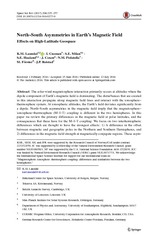North–South Asymmetries in Earth’s Magnetic Field. Effects on High-Latitude Geospace
Laundal, Karl Magnus; Cnossen, Ingrid; Milan, Stephen Eric; Haaland, Stein; Coxon, John C.; Pedatella, Nick; Förster, Matthias; Reistad, Jone Peter
Peer reviewed, Journal article
Published version

Åpne
Permanent lenke
https://hdl.handle.net/1956/15950Utgivelsesdato
2017-03Metadata
Vis full innførselSamlinger
Originalversjon
https://doi.org/10.1007/s11214-016-0273-0Sammendrag
The solar-wind magnetosphere interaction primarily occurs at altitudes where the dipole component of Earth’s magnetic field is dominating. The disturbances that are created in this interaction propagate along magnetic field lines and interact with the ionosphere–thermosphere system. At ionospheric altitudes, the Earth’s field deviates significantly from a dipole. North–South asymmetries in the magnetic field imply that the magnetosphere–ionosphere–thermosphere (M–I–T) coupling is different in the two hemispheres. In this paper we review the primary differences in the magnetic field at polar latitudes, and the consequences that these have for the M–I–T coupling. We focus on two interhemispheric differences which are thought to have the strongest effects: 1) A difference in the offset between magnetic and geographic poles in the Northern and Southern Hemispheres, and 2) differences in the magnetic field strength at magnetically conjugate regions. These asymmetries lead to differences in plasma convection, neutral winds, total electron content, ion outflow, ionospheric currents and auroral precipitation.
